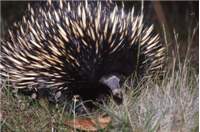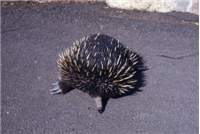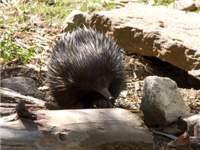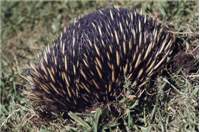Family
TachyglossidaeGenus
Tachyglossus
Species
aculeatusThreats/Control Methods - Regional
Disturbance of remnant habitat areas by expansion of urban and peri-urban development is a threat to regional Echidna populations.
Threats/Control Methods - Local
Echidnas' main local threats are Dogs, Cats, and roads, on which they are often run over.Local/Urban Actions
Canberrans can assist the survival of local Echidnas by keeping Cats out of bushland areas, and maintaining control of Dogs when in bushland habitat areas.Common name/s
Echidna, Short-beaked Echidna, Spiny Anteater
Distinguishing Features
The Echidna is easily recognisable due to the spines that cover its back. Dark, thick fur is present between the spines. They can grow to 45cm, although generally average around 35cm.
Similar Species
No similar species exist in
Distribution
The Echidna is a very widespread species, occurring across
Country of Origin
Australia
Survey Techniques
Echidnas are detected during surveys by their diggings, scats or by active searches.
Conservation (Pet/Pest) Status - National
Common across the country, although local populations are often small.
Conservation (Pet/Pest) Status - Regional
Sparse populations found in bushland areas around the ACT.
LSCCES Population
Found during the LSCC survey at low numbers.
Associated vegetation community
Limiting Resources
The only particular limiting resource for Echidnas is an adequate supply of ants and termites.
Breeding
Mating occurs in late winter, with a single egg laid directly into the female's pouch. This egg hatches about 10 days later, after which the baby Echidna suckles in the pouch for many months. Eventually, the young will leave the pouch, but stay in a burrow, to which the mother returns to feed it. Juveniles first tend to be emerge from the burrow at around 1 year old.
Behaviour
Echidna's are solitary, except during mating season. Generally Echidna's are active at dawn and dusk, but in hot areas they tend to be active at night, while in cold areas, including the mountains around Canberra, Echidnas hibernate during the colder months. Echidnas shelter under bushes, in logs or in burrows, but will not confine themselves to a particular shelter place except when rearing young.
Functional Group
Insectivore
Food Species
The Echidna feeds on ants and termites, breaking into their nest and catching them by extending its long sticky tongue.
Predators
Adult Echidna's are well protected from predation by their spines, although they may occasionally be attacked by Dingos. Young Echidna's are more vulnerable and may be taken by Goannas. Around urban areas, domestic or feral Cats and Dogs may prey on the Echidna.
Interesting Fact
In winter and early spring, Echidnas can be seen in Canberra Nature Park, walking in a line. This ritual involves a female being followed by several males, and can last for several weeks. Eventually, the female will allow the lead male to mate with her.
The Echidna is one of only three species of mammal in the world known to lay eggs. The others are the Long-beaked Echidna (Zaglossus bruijni) of New Guinea and the Platypus (Ornithorhynchus anatinus ).
References - (reader suitability of references, P=Primary teachers, S=Secondary students, T=Tertiary students and researchers)
Books:Strahan R (ed), 1995. The Mammals of Australia. Australian Museum/Reed Books, Sydney. S, T
Online References:Australian Broadcasting Corporation (ABC), 2006. 'Spring in Canberra Nature Park' S, Thttp://www.abc.net.au/canberra/stories/s1738748.htm[accessed 14/6/07]
Department of the Environment and Water Resources. "Tachyglossidae". Australian Biological Resources Study. S, Thttp://www.environment.gov.au/cgi-bin/abrs/fauna/details.pl?pstrVol=PROTOTHERIA;pstrTaxa=20;pstrChecklistMode=1 [accessed 14/6/07]
Stewart D, 2003. "The Enigma of the Echidna" in National Wildlife, vol 41. no. 3. S, Thttp://www.nwf.org/nationalwildlife/article.cfm?articleId=763&issueId=61[accessed 14/6/07]
Researcher: Ian Rayner




 Top
Top Top
Top